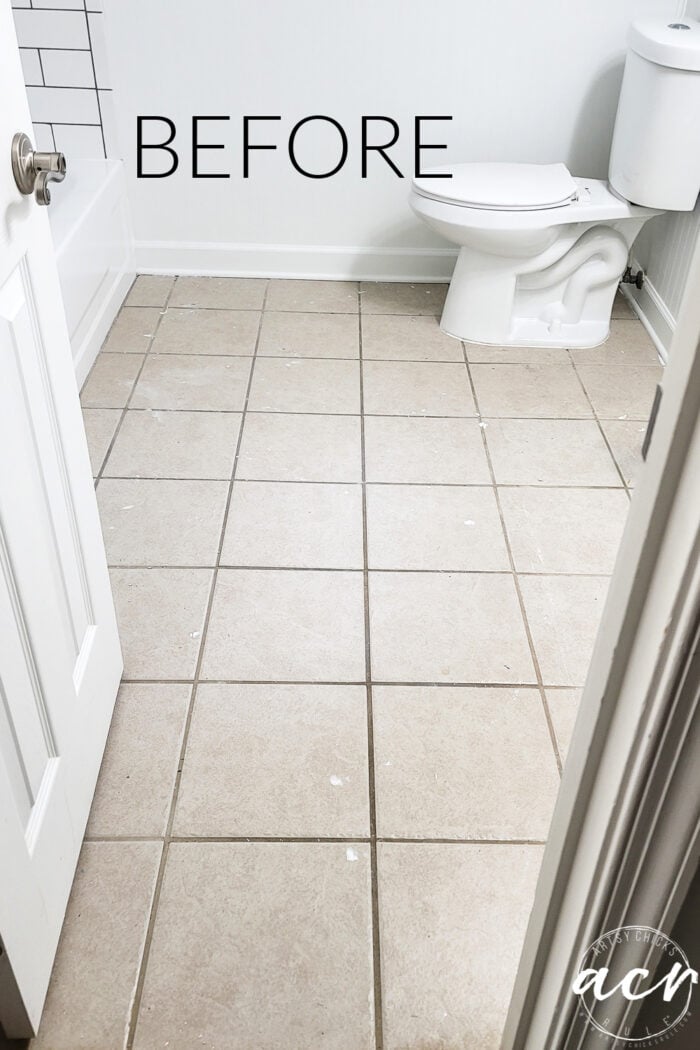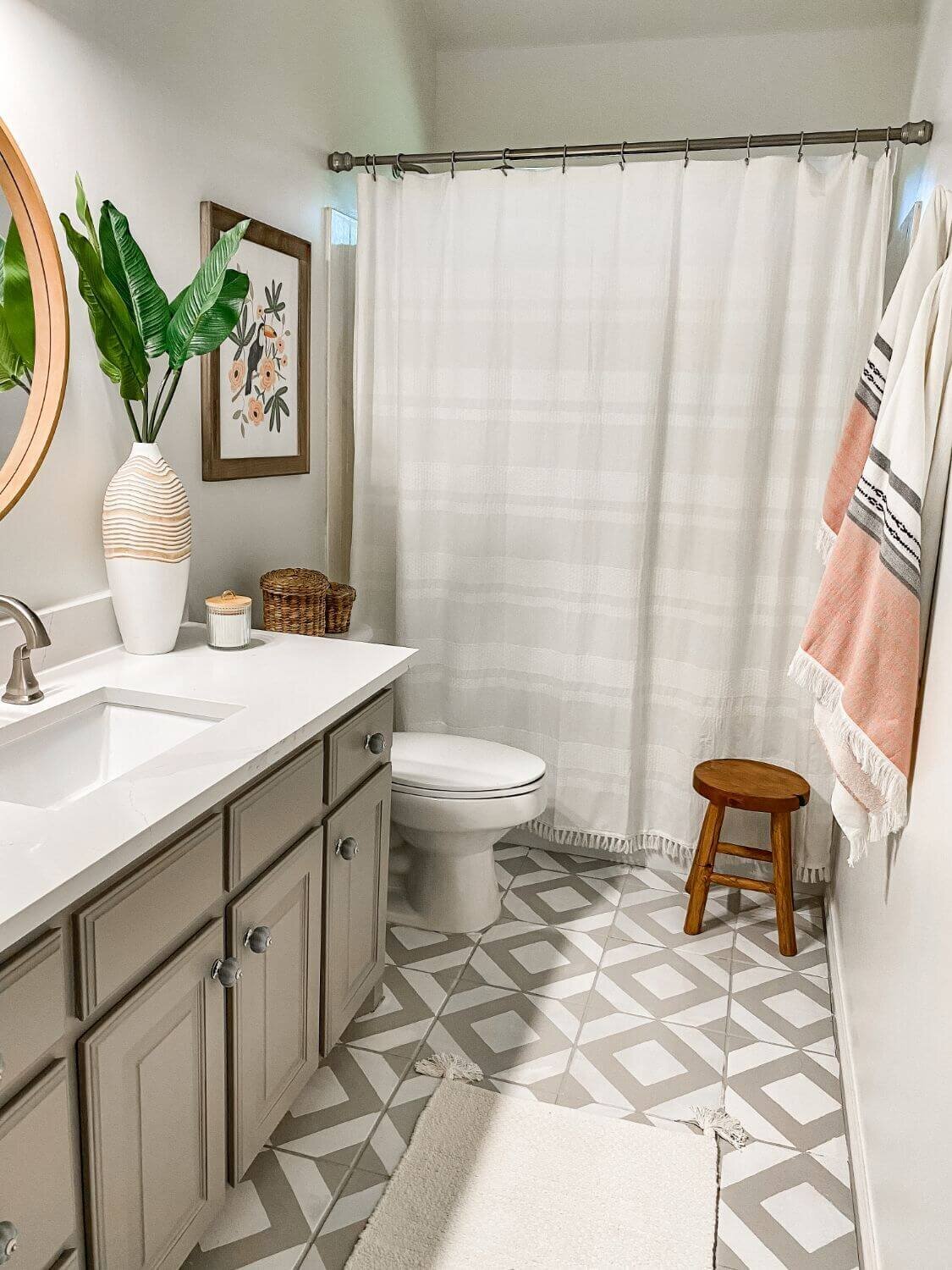Painting bathroom floor tiles can refresh the space and save money on renovations. Use high-quality tile paint for durability and a smooth finish.
Renovating a bathroom can be expensive, but painting floor tiles offers an affordable alternative. This simple project can dramatically change the room’s appearance without the need for costly replacements. With the right materials and techniques, you can achieve a fresh, stylish look that lasts.
Many homeowners choose tile paint for its versatility and ease of application. It allows for a wide range of colors and finishes, providing a custom look. Whether you prefer a sleek modern vibe or a classic design, painted tiles can meet your aesthetic goals while enhancing your bathroom’s overall appeal.

Credit: www.artsychicksrule.com
Introduction To Tile Painting
Tile painting is a popular way to refresh your bathroom. It offers a budget-friendly solution to update old floor tiles. This method allows you to express your style without a complete remodel. Let’s explore why many homeowners choose this option.
Why Choose Paint?
Painting bathroom floor tiles offers several benefits:
- Cost-Effective: Painting is cheaper than replacing tiles.
- Quick Transformation: You can see results in just a few hours.
- Variety of Colors: Choose any color that fits your style.
- Easy Application: Many DIY kits are available.
These reasons make tile painting an attractive choice for many homeowners.
The Pros And Cons
| Pros | Cons |
|---|---|
| Inexpensive compared to replacement | Durability may not match original tiles |
| Quick and easy process | Requires regular maintenance |
| Customizable to your taste | Risk of peeling over time |
| Less mess than remodeling | May need special primers and paints |
Weigh these pros and cons before starting your tile painting project. The right preparation and materials can lead to great results.
Preparation Is Key
Preparing your bathroom floor tiles is essential. Proper preparation ensures that the paint adheres well. It also helps achieve a smooth and lasting finish. Follow these steps for a successful project.
Cleaning The Tiles
Start with a thorough cleaning of your tiles. Dirt and grime will affect paint adhesion. Use the following steps:
- Remove any furniture or items from the floor.
- Sweep or vacuum to eliminate dust and debris.
- Mix warm water with a few drops of dish soap.
- Use a scrub brush to clean the tiles.
- Rinse with clean water and let dry completely.
Make sure all dirt and soap residue are gone. This step is crucial for a successful paint job.
Gathering Your Supplies
Having the right supplies makes the job easier. Here’s a list of what you need:
| Item | Purpose |
|---|---|
| Tile Cleaner | Cleans the surface effectively. |
| Paint Primer | Prepares the tiles for paint. |
| Floor Paint | Provides color and durability. |
| Paint Roller | Applies paint evenly. |
| Painter’s Tape | Protects edges from paint. |
Gather these supplies before starting. This will save time and prevent interruptions.
Choosing The Right Paint
Choosing the right paint is crucial for your bathroom tiles. Not all paints work well on tile surfaces. The right choice ensures durability and a stunning finish.
Types Of Paint Suitable For Tiles
Consider these types of paint for your bathroom tiles:
- Epoxy Paint: Highly durable and water-resistant.
- Latex Paint: Easy to apply and clean. Suitable for less humid areas.
- Specialized Tile Paint: Formulated specifically for tile surfaces.
Each paint type has its benefits. Epoxy paint is best for heavy use areas. Specialized tile paint offers great adhesion.
Color Selection Tips
Choosing the right color enhances your bathroom’s look. Follow these tips:
- Consider the Size: Light colors make small spaces feel larger.
- Match the Décor: Choose colors that complement your existing design.
- Test Samples: Apply small samples on tiles to see how they look.
- Think About Lighting: Natural and artificial light can change color appearance.
Use a color wheel for inspiration. Create a harmonious look with complementary colors.
Step-by-step Painting Guide
Transforming your bathroom floor tiles is simple. Follow this easy guide. Each step ensures a smooth finish. Enjoy a fresh look in your bathroom.
Priming The Surface
Start with a clean surface. Remove dirt and grime. Use a strong cleaner. Rinse thoroughly and let it dry.
Apply a primer suitable for tiles. This helps paint stick better. Use a paintbrush or roller for even coverage.
Allow the primer to dry completely. Check the manufacturer’s instructions for drying time.
Applying The First Coat
Choose a durable tile paint. Use a roller for larger areas. A brush works well for edges and corners.
- Start from one corner.
- Work your way across the room.
- Apply thin layers for best results.
Let the first coat dry. Follow the paint instructions on drying time.
Letting It Dry
Drying time is crucial. Avoid walking on the tiles during this period. This prevents smudges and marks.
Check for any uneven spots. Touch them up if needed. Wait for the recommended time before moving on.
Adding Subsequent Coats
Once the first coat is dry, apply a second coat. This improves color and durability.
- Use the same method as before.
- Ensure even coverage on all tiles.
- Allow each coat to dry fully.
Two to three coats often work best. Follow the paint’s instructions for the best finish.
Creative Design Ideas
Transform your bathroom floor tiles with unique and exciting designs. Painting tiles offers endless possibilities. Use your creativity to turn plain tiles into stunning art pieces. Here are some ideas to inspire your next project.
Stenciling Techniques
Stenciling is a simple yet effective way to add flair. It allows for precise designs and easy application. Follow these steps:
- Choose a stencil design that matches your style.
- Secure the stencil onto the tile with tape.
- Use a small brush for detailed painting.
- Carefully remove the stencil before the paint dries.
- Seal the design with a clear topcoat.
Popular stencil designs include:
- Geometric shapes
- Floral patterns
- Chevron stripes
- Abstract art
Creating Patterns And Textures
Patterns and textures can add depth to your bathroom floor. Use different techniques to achieve stunning effects:
| Technique | Description |
|---|---|
| Sponging | Use a sponge to create a mottled effect. |
| Rag Rolling | Roll a rag for a unique textured finish. |
| Ombre | Blend colors for a gradient effect. |
| Color Wash | Apply a thin layer of color for a soft look. |
Mix and match techniques for a personalized touch. Play with colors to create a vibrant atmosphere. Use contrasting shades to make your floor stand out.
Maintenance And Care
Keeping your painted bathroom floor tiles looking fresh requires regular maintenance. Proper care extends the life of the paint and maintains its vibrant look. Follow these tips for easy upkeep.
Daily Cleaning Tips
Daily cleaning helps prevent dirt buildup. Use these simple tips:
- Use a soft broom or microfiber cloth to sweep.
- Mop with warm water and a gentle cleaner.
- Avoid harsh chemicals that can damage the paint.
- Dry the floor with a soft towel to prevent water spots.
For stubborn stains, use a mild soap solution. Rinse well and dry immediately. Regular cleaning keeps your tiles shiny and new.
Dealing With Chips And Scratches
Chips and scratches can happen. Fix them quickly to maintain the floor’s appearance. Follow these steps:
- Identify the damage on the tiles.
- Clean the area with a damp cloth.
- Use a touch-up paint that matches your tiles.
- Apply the paint carefully with a small brush.
- Let it dry completely before walking on it.
For larger damage, consider repainting the affected area. This keeps your bathroom floor looking its best.
Common Mistakes To Avoid
Painting bathroom floor tiles can transform your space. Avoiding common mistakes ensures a smooth and lasting finish. Here are key pitfalls to watch for.
Skipping Preparation Steps
Proper preparation is crucial for a successful paint job. Neglecting this can lead to poor adhesion and early wear.
- Clean the tiles thoroughly.
- Remove any dirt or grime.
- Fill in cracks and chips.
- Sand the surface for better grip.
Skipping these steps can result in peeling paint. Always make sure your tiles are ready before applying paint.
Using The Wrong Tools
The right tools make a huge difference. Using inappropriate tools can ruin your project.
| Tool | Purpose | Common Mistake |
|---|---|---|
| Paint Roller | Even application | Using a brush instead |
| Tile Primer | Better adhesion | Skipping primer |
| Paint Tray | Easy access | Pouring paint directly |
Using the right tools prevents frustration and ensures the best results. Invest in quality supplies for your project.

Credit: farmhouseliving.com
Real-life Transformation Stories
Painting bathroom floor tiles can change the entire look of a space. Many homeowners have experienced stunning transformations. Let’s dive into some inspiring stories that showcase the magic of this DIY project.
Before And After
Take a look at these amazing transformations:
| Before | After |
|---|---|
 |
 |
 |
 |
 |
 |
Each transformation tells a story of creativity and effort. Homeowners have turned dull, old tiles into vibrant, stylish floors.
Testimonials
Here are some real experiences from happy homeowners:
- Sarah J.: “I couldn’t believe the change! My bathroom feels brand new.”
- Tom L.: “The project was easy and fun. I love my new tiles!”
- Emily R.: “This DIY saved me a lot of money. Worth every effort!”
- John D.: “I never thought painting tiles could look this good!”
These stories show how painting bathroom floor tiles can create stunning results. Homeowners feel proud of their spaces.

Credit: m.youtube.com
Frequently Asked Questions
Can Bathroom Floor Tiles Be Painted?
Yes, bathroom floor tiles can be painted. Use a high-quality tile paint for durability. Ensure the surface is clean and dry before application. A primer may enhance adhesion. Expect to repaint every few years, as wear can affect the finish.
Proper maintenance will extend the life of the paint.
Is Painting Bathroom Tiles A Good Idea?
Painting bathroom tiles can be a cost-effective way to refresh your space. It allows for color changes without replacing tiles. Choose high-quality paint designed for tiles to ensure durability. Keep in mind that it may require periodic touch-ups. Overall, it’s a practical solution for a quick makeover.
What Kind Of Paint Will Stick To Bathroom Tile?
Use acrylic or epoxy-based paint specifically designed for tile surfaces. Ensure the tile is clean and dry before application. A primer can enhance adhesion and durability. Choose paint labeled for high-moisture areas to prevent peeling and mildew. Always follow manufacturer instructions for the best results.
What Type Of Paint To Use On A Bathroom Floor?
Use epoxy or polyurethane paint for bathroom floors. These types resist moisture and mold effectively. Choose a non-slip finish for safety. Ensure proper surface preparation before application for the best results. Always check for mold and mildew resistance to maintain a healthy environment.
Conclusion
Painting bathroom floor tiles can transform your space beautifully. It’s an affordable and creative way to refresh your home. With the right materials and techniques, anyone can achieve stunning results. Embrace this DIY project to enhance your bathroom’s aesthetic. Enjoy your newly painted tiles and the satisfaction of a job well done!
